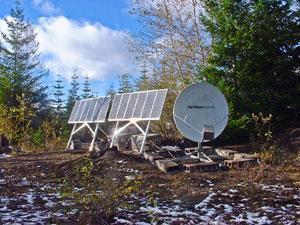(From ScienceDaily)New research on infrasound from volcanic eruptions shows an unexpected connection with jet engines. Researchers at Scripps Institution of Oceanography at UC San Diego speeded up the recorded sounds from two volcanoes and uncovered a noise very similar to typical jet engines.
These new research findings provide scientists with a more useful probe of the inner workings of volcanic eruptions. Infrasound is sound that is lower in frequency than 20 cycles per second, below the limit of human hearing.
The study led by Robin Matoza, a graduate student at Scripps Oceanography, will be published in an upcoming issue of the journal Geophysical Research Letters, a publication of the American Geophysical Union (AGU). Matoza measured infrasonic sound from Mount St. Helens in Washington State and Tungurahua volcano in Ecuador, both of which are highly active volcanoes close to large population centers.
"We hypothesized that these very large natural volcanic jets were making very low frequency jet noise," said Matoza, who conducts research in the Scripps Laboratory for Atmospheric Acoustics.
Using 100-meter aperture arrays of microbarometers, similar to weather barometers but sensitive to smaller changes in atmospheric pressure and low-frequency infrasonic microphones, the research team tested the hypothesis, revealing the physics of how the large-amplitude signals from eruptions are produced. Jet noise is generated by the turbulent flow of air out of a jet engine. Matoza and colleagues recorded these very large-amplitude infrasonic signals during the times when ash-laden gas was being ejected from the volcano. The study concluded that these large-scale volcanic jets are producing sound in a similar way to smaller-scale man-made jets.
"We can draw on this area of research to speed up our own study of volcanoes for both basic research interests, to provide a deeper understanding of eruptions, and for practical purposes, to determine which eruptions are likely ash-free and therefore less of a threat and which are loaded with ash," said Michael Hedlin, director of Scripps' Atmospheric Acoustics Lab and a co-author on the paper.
Large-amplitude infrasonic signals from volcanic eruptions are currently used in a prototype real-time warning system that informs the Volcanic Ash Advisory Center (VAAC) when large infrasonic signals have come from erupting volcanoes. Researchers hope this new information can improve hazard mitigation and inform pilots and the aviation industry.
"The more quantitative we can get about how the sound is produced the more information we can provide to the VAAC," said Matoza. "Eventually it could be possible to provide detailed information such as the size or flow rate of the volcanic jet to put into ash-dispersal forecasting models."
The paper's co-authors include D. Fee and M A. Garces, Infrasound Laboratory at the University of Hawaii at Manoa; J.M. Seiner of the National Center for Physical Acoustics at the University of Mississippi; and P.A. Ram??n of Instituto Geofisico, Escuela Politecnica Naional. The research study was funded by a National Science Foundation grant.
Adapted from materials provided by University of California - San Diego.

Scripps researchers installed an array of microbarometers
at Mount St. Helens in November 2004
to collect infrasound near the site.
(Credit: Image courtesy of University of California - San Diego) |